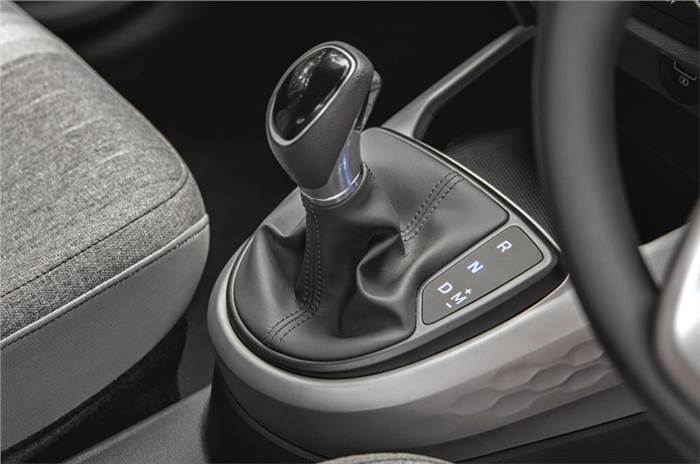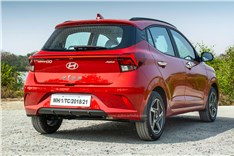Hyundai Grand i10 Nios review, road test
This new generation of the Grand i10 has a lot to offer. But does it tick all the right boxes?
Published on Jan 07, 2020 06:00:00 AM
1,39,044 Views
Follow us on

Sportz (top spec for AMTs) gets stylish alloys with 165/70 R14 tyres.

Ample charging provisions, including a wireless charging pad. 12V socket present at the rear too.

Digital speedo with an analogue tachometer is a nice combination.
Powering the petrol Nios is the familiar 1,197cc, four-cylinder unit that has now been made BS6 compliant. Hyundai claims to have improved thermal efficiency and made modifications to the variable valve timing, thereby reducing frictional losses to improve performance as well as refinement. However, Hyundai hasn’t been able to mask that peculiar thrum that filters into the cabin and the noticeable vibrations felt at the steering wheel.
Once on the move though, the engine feels extremely smooth and refined, and sound insulation is very good. What’s nice is that this petrol responds well to part throttle inputs and it will keep up with traffic as long as you aren’t in a hurry; so as a point A to B commuter, the Nios does its job rather competently. Power delivery is linear but isn’t seamless and has distinctive steps. The engine gets on the boil once the tacho needle goes past 2,500revs. From thereon, it pulls well until 4,500revs, and once past 5,000, it gets a second wind up to a little over 6,000rpm. Enthusiastic drivers will find themselves revving the guts out of this engine asking for more, but they aren’t going to get anything more than a modest set of performance figures.

Although the Grand i10 Nios’ power and torque numbers are identical to the Maruti Swift’s, performance isn’t as exciting – its outright acceleration time from 0-100kph of 13.28sec is 1.3sec slower – and even through the gears the Nios isn’t as quick. The manual transmission is the familiar slick-shifting 5-speed unit paired with a light clutch, and this makes driving around a rather stress-free task. The other transmission is a 5-speed automated manual transmission (AMT), for which Hyundai has ditched the more expensive and inefficient 4-speed torque converter automatic that did duty on the Grand i10. Sure, it doesn’t quite match the smoothness of the torque converter, but as far as AMTs go, it is one of the best out there. The typical ‘head-nod’ while transitioning from first to second gear is still present, but after that, the shifts are smooth and less abrupt. The transmission’s crawl function is very progressive and it makes driving in bumper-to-bumper traffic smooth and easy. And this goes for hill starts too. The Nios rolls back a tad bit until the crawl kicks in and holds you in position. You also get a mode to change gears manually, but it’s best to leave it in auto mode to enjoy the benefits of this transmission.
At a time when manufacturers are steering away from diesels, Hyundai continues to offer its three-cylinder, U2 CRDi engine that makes 75hp and 190Nm of torque. There’s that familiar diesel clatter at idle, but it irons out once on the move, and overall refinement is so good, this is easily the smoothest motor when compared to its rivals like the Maruti Swift and Ford Figo. Even when cruising at a steady 100kph, the engine is spinning at 2,500rpm, with nothing but a faint thrum from the engine. So while it is an able cruiser, it’s in the city where this motor shines with almost negligible lag. Its strong bottom-end and mid-range, coupled with well-judged gear ratios, ensures that there’s ample performance on tap while ambling around town; and these also make it rather effortless to drive around without demanding constant gearshifts. The diesel’s powerband, however, tapers drastically beyond 3,500rpm, and the motor sounds coarse and feels strained in the last 1,200revs. This lack of top-end performance results in a lazy 0-100kph time of 14.54sec, which is over a second slower than the diesel Swift. The engine isn’t BS6 compliant just yet, and it is likely to be upgraded with the help of a LNT (Lean NOx Trap), DPF (Diesel Particulate Filter) and new high-pressure injectors, amongst other modifications, to make it BS6 compliant in the coming months. Alongside the slick 5-speed manual, there’s now an automatic or AMT option, making this the first sub-Rs 10-lakh Hyundai to get a diesel-automatic combination. The shift characteristics of this unit are similar to the petrol-AMT’s, however the first few gear changes are slightly jerky, with a relatively longer pause between shifts. With a relaxed foot, it works perfectly fine, and it does a great job of combining diesel’s economy and the convenience of an automatic. Needless to say, should you rush the gearbox, you’d be disappointed as the diesel-AMT is the slowest of the range when it comes to outright performance.
Copyright (c) Autocar India. All rights reserved.






Comments
Member Login
Personal Details
No comments yet. Be the first to comment.